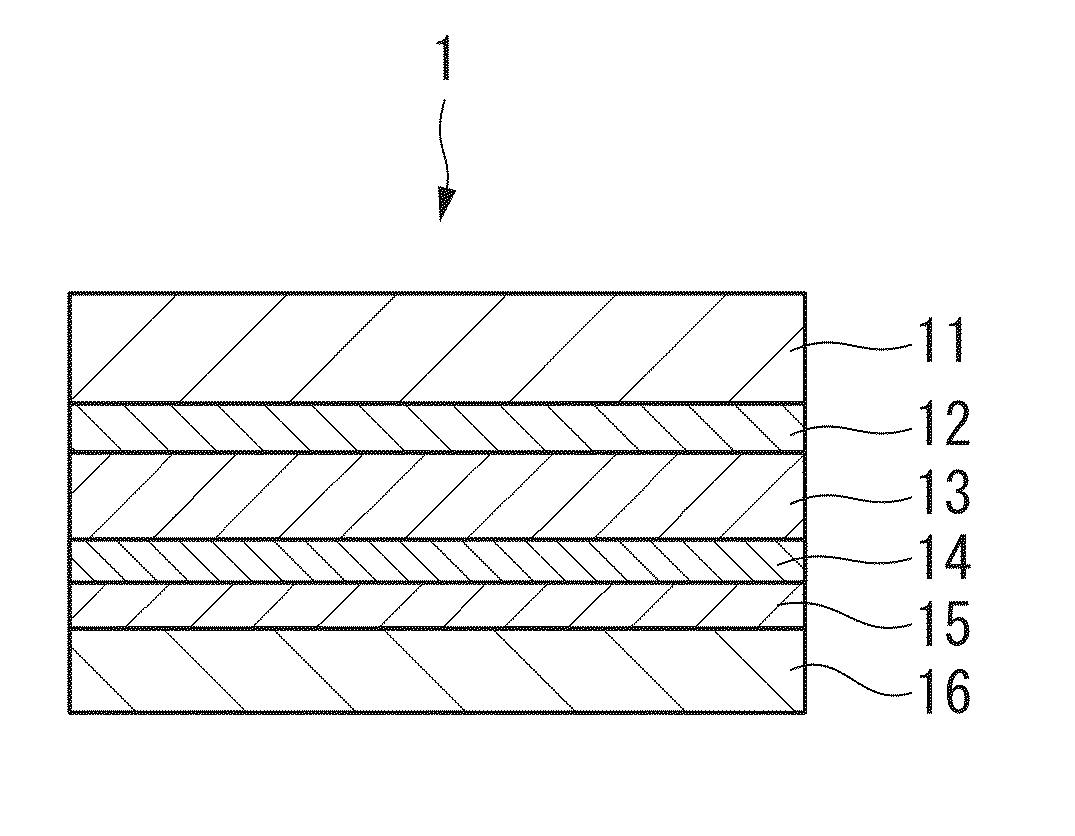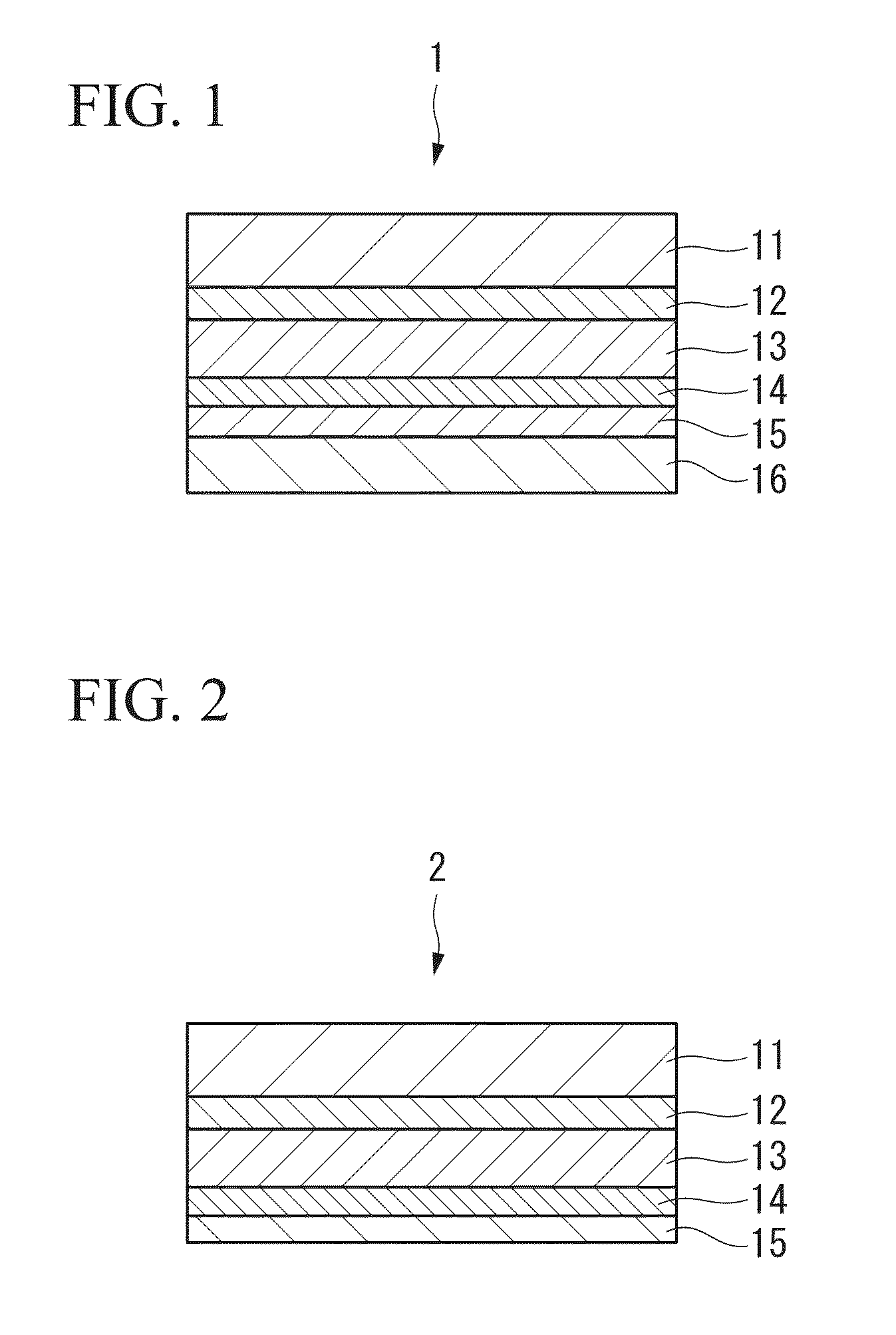Lithium ion battery exterior material
a lithium ion battery and exterior material technology, applied in the direction of cell components, cell components, jackets/cases materials, etc., can solve the problems of reducing the lamination strength between each layer of multi-layer laminated film, and affecting the performance of lithium ion batteries. , to achieve the effect of corrosion, and reducing the risk of rus
- Summary
- Abstract
- Description
- Claims
- Application Information
AI Technical Summary
Benefits of technology
Problems solved by technology
Method used
Image
Examples
first embodiment
[0099]The following provides a detailed explanation of a first embodiment of the exterior material of the present invention. FIG. 1 is a cross-sectional view showing an exterior material 1 that is an example of an exterior material according to a first embodiment of the present invention. FIG. 2 is a cross-sectional view showing an exterior material 2 that shows another example of an exterior material according to the first embodiment of the present invention.
[0100]As shown in FIG. 1, the exterior material 1 comprises sequentially laminating an adhesive layer 12, an aluminum foil layer 13, a corrosion prevention treated layer 14, an adhesive resin layer 14 and a sealant layer 16 on a first surface (one surface) of a base material layer 11. The exterior material 2 is the same as the exterior material 1 with the exception of not being provided with the sealant layer 16. Namely, the exterior material 2 is comprised by sequentially laminating the adhesive layer 12, the aluminum foil lay...
example 1
[0272]A single film of an adhesive resin layer was produced by using only the acid-modified polyolefin resin E1 without adding the miscible elastomers E2 and E3 followed by measurement of withstand voltage and evaluation of electrical insulating properties. The evaluation results are shown in Table 1.
examples 2 to 15
[0273]Single films of adhesive resin layers were produced using adhesive resins obtained by adding and mixing the miscible elastomers E2 and E3 with the acid-modified polyolefin resin E1 at the ratios shown in Table 1 using a twin-screw extruder followed by measurement of withstand voltage and evaluation of electrical insulating properties. The evaluation results are shown in Table 1.
TABLE 1Added amountof miscibleelastomers (wt %)Withstand voltageE2E3(kV / μm)(kV / 20 μm)EvaluationExample 1——0.030.60BadExample 2 5—0.051.00FairExample 310—0.081.60GoodExample 420—0.112.20GoodExample 530—0.122.40GoodExample 640—0.122.40GoodExample 750—0.122.40GoodExample 860—0.122.40GoodExample 9— 50.040.80FairExample 10—100.071.40GoodExample 11—200.102.00GoodExample 12—300.112.20GoodExample 13—400.122.40GoodExample 14—500.122.40GoodExample 15—600.122.40Good
[0274]As shown in Table 1, the elastic resin layers of Examples 2 to 15 in which miscible elastomer E2 or E3 dispersed at a dispersed phase size of 1 n...
PUM
| Property | Measurement | Unit |
|---|---|---|
| Temperature | aaaaa | aaaaa |
| Temperature | aaaaa | aaaaa |
| Temperature | aaaaa | aaaaa |
Abstract
Description
Claims
Application Information
 Login to View More
Login to View More - R&D
- Intellectual Property
- Life Sciences
- Materials
- Tech Scout
- Unparalleled Data Quality
- Higher Quality Content
- 60% Fewer Hallucinations
Browse by: Latest US Patents, China's latest patents, Technical Efficacy Thesaurus, Application Domain, Technology Topic, Popular Technical Reports.
© 2025 PatSnap. All rights reserved.Legal|Privacy policy|Modern Slavery Act Transparency Statement|Sitemap|About US| Contact US: help@patsnap.com



